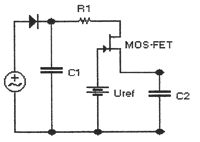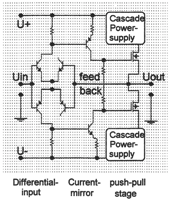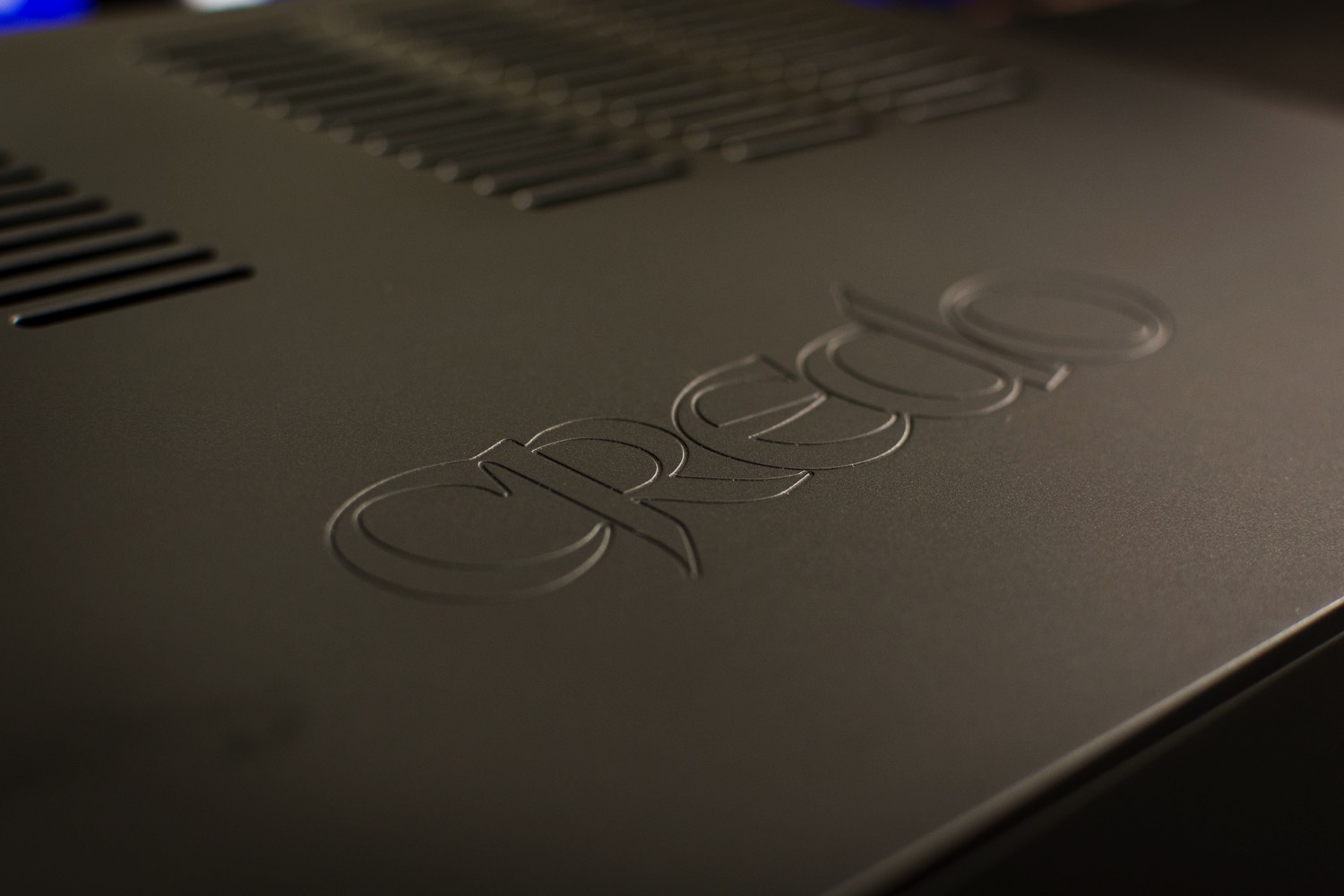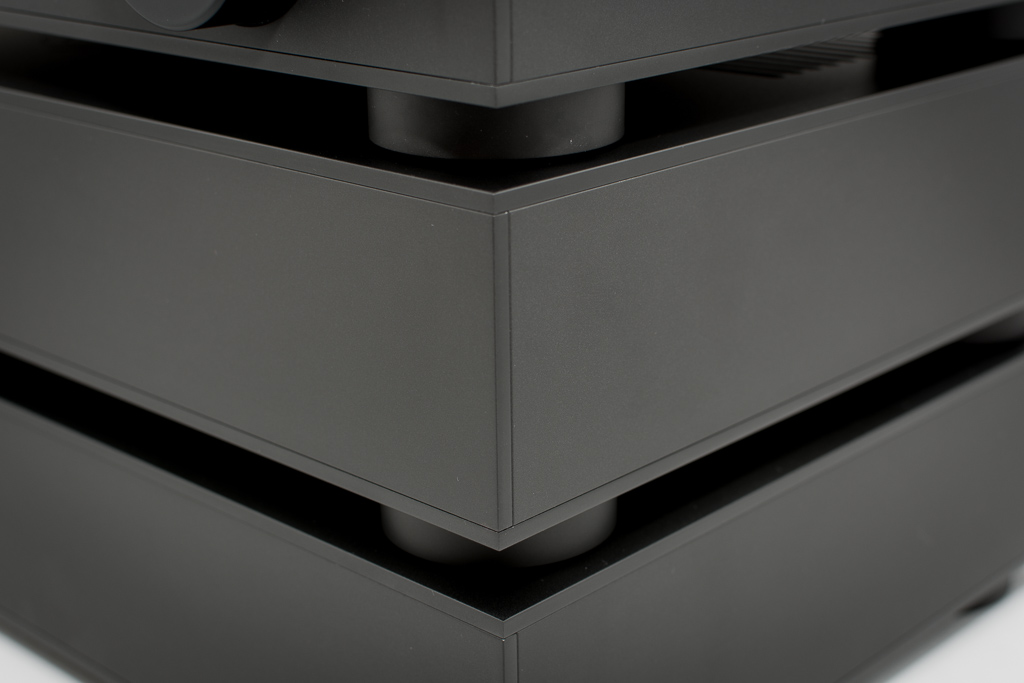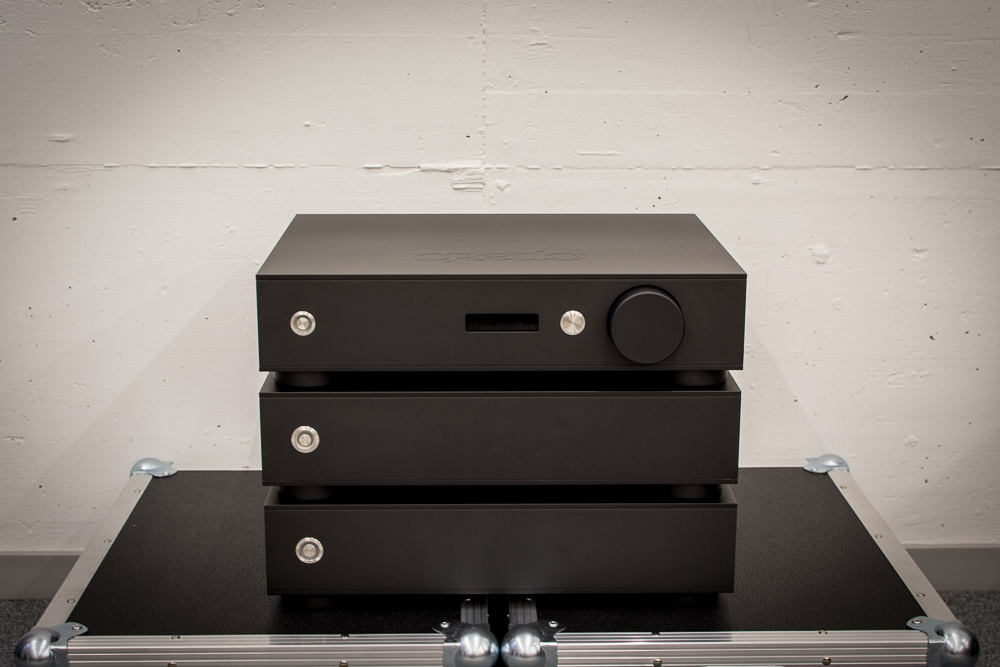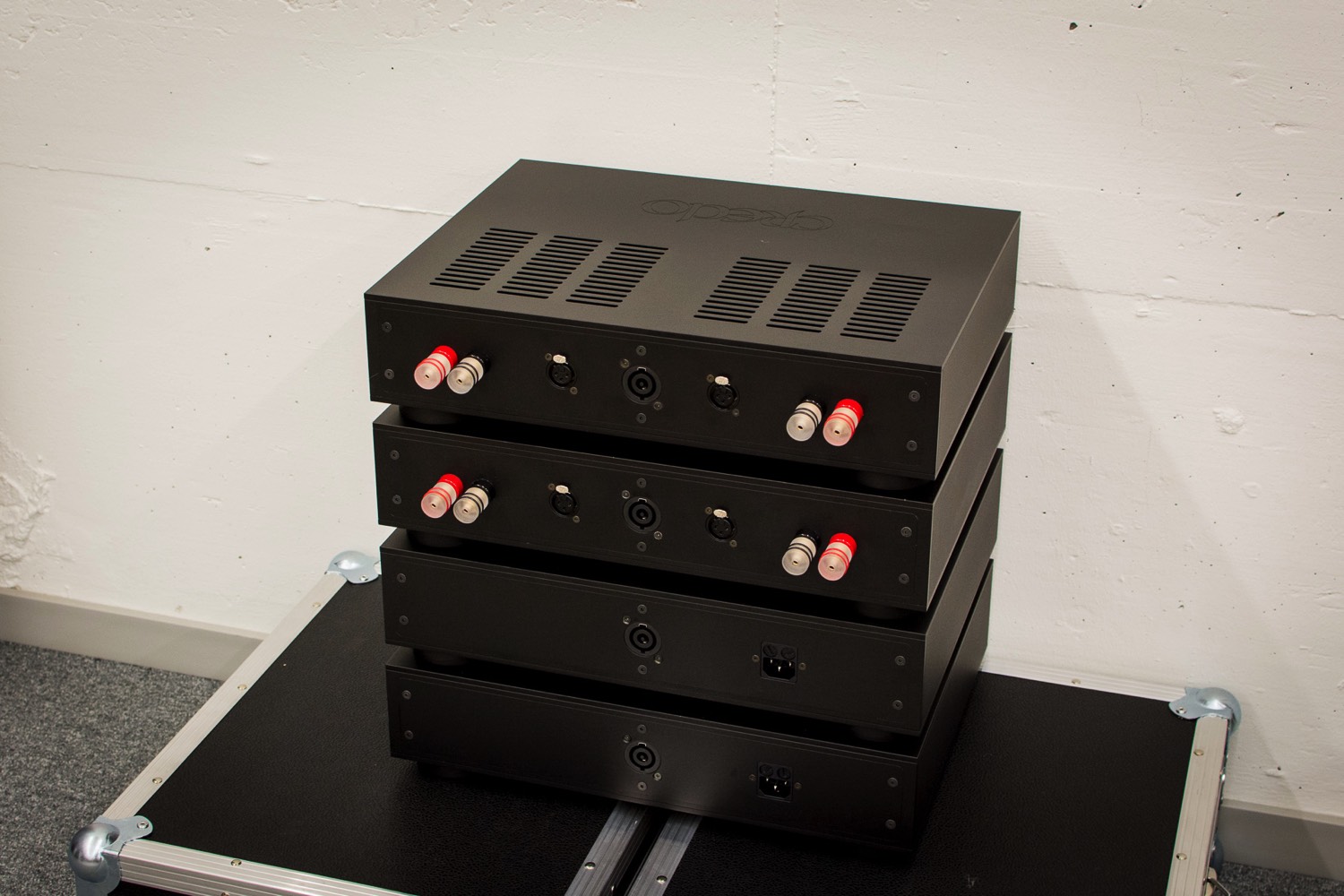Preview: Credo Audio System - The Amp
To get the best out of your Credo Speaker's:
We made our amplifier even better.
We made our amplifier even better.
- Fully balanced signal path
- Build in dual-mono
- Patented "Cascade PSU"
- Pure Silver transformer coupled
- Cabinet made of 10mm full aluminum
- 2 x balanced inputs
- Transformers in external cabinet
Credo’s Power Amplifier
The Credo power amplifier responds to the clients request for solid, reliable high end performance. Our amplifier can be used with almost any commercial loudspeaker system. The internal design is based on classical circuits - adapted for most modern components. We use a pure class A driver for the class AB output stage is.
Thanks to Credo's unique cascade power supply we succeed in reducing the dynamic internal resistance of the amplifier, thus increasing the dynamic damping factor significantly. We therefore do not need to limit the cutoff frequency to 20 kHz but rather increase the frequency range to 200 kHz. Because of the large bandwidth there are practically no in- and out- rush oscillations. Credo's amplifiers reach the indicated output power at all frequencies up to 20 kHz which gives the feeling of unlimited power. As a result we obtain an undistorted response to large, fast and steep input signals. To reduce cross talk, we use two separate power supplies for the right and left channels. The amplifier is also equipped with separate transformers for each channel. Thus a real dual mono setup without compromise is delivered.
The figure (fig.2) shows the principle elements of our amplifier. Credo's power amplifiers are built in a completely symmetrical way from the very sensitive differential input trough the current mirror amplification stage to the push-pull current amplifying output stage. The circuit uses complimentary, selected and matched transistors and MOSFET's through‐ out. We use lateral MOSFET’s and achieved a very powerful amplifier with fast slew rates and very low distortion.
This technique is known to reduce higher order distortions. The short signal path minimizes delays and phase shifts in the feed back loop. Our really unique cascade power supply is on the same circuit board as the amplifier.
The „soft start-module“ and the two toroidal transformers come in an extra cabinet to avoid interference with the amplifier. The transformers are built in the EU to our specifications. Because of their closed ring-shaped cores, our toroidal transformers have approximately 85–95% lower stray field than conventional laminated transformers. Achieving low levels of stray field is important, it can create unwanted noise through interference with the wide-band and sensitive electronics. In addition, the transformers are shielded shed to further reduce magnetic interference.
Our double-layer circuit board is highly optimized to provide shortest signal-paths. It has massive layers from the PSU to the power transistors - the speaker output is placed as close to the transistors as possible. The circuit boards are made in Switzerland and completely hand-assembled in our manufactory!
Of course only best in- and output terminals are used. The inputs are wired with pure-silver cables, we use CU N6 copper wires for the speaker-outputs.
The Cascade Power-Supply
In analogy to a cascade, where water flows from a high level to a low one, we called this device a cascade power‐supply. The charges flow from a high potential at C1 through the FET to a lower potential at C2. This flow of charge is regulated by a stable reference voltage, Uref, applied to the gate of the FET. This reference voltage has to be independent of the load applied to the power-supply and is therefore taken from a separate DC source. If the potential Uout reaches this
reference voltage loading of C2 stops because the FET closes. If current is drawn from the output the output potential slightly drops, the FET opens and additional charges are drawn from C1 leaving the potential Uout fairly constant. There is no feed back from the output to the gate of the FET.
Now that we understand the principle of this very effective cascade power-supply let's look at some technical details and compare it to a classical power-supply built by one rectifier and a large capacitor. These capacitors are usually very large, 20 mF and more are often used to reduce the potential fluctuations when large currents are drawn by the amplifier. Most of the charges in there are never used. In contrast, C1 in a cascade power-supply is small. 3.3 mF only. If maximal output current is drawn the output voltage at C2 drops slightly and because the charges are mainly supplied from C1 the large drop in potential occurs there. The capacitor C2 acts as a buffer for fast signals and as additional source of charges for even higher current output peaks. The resistor R1 limits the current and thus protects the FET. Because Uref is independent of the current drawn, the output voltage almost immediately returns to a value close to Uref even after a short circuit Situation. The large potential drop at C1 uses the charges stored in there more efficiently. Practically the capacitors C1 and C2 are smaller and can therefore be integrated on the printed circuit board. This reduces the amount of cables and shortens the connections to the output MOS-FET of the amplifier. A further advantage is the longer time available for recharging the capacitor C1. The peak currents drawn from the supply are therefore smaller, making better use of the transformer and demanding less from the mains. In August 1993, the patent for our stabilized DC power supply was registered.
An amplifier equipped with a cascade power-supply has ample current available rapidly. Thus the amplifier has not to correct the drop in supply voltage as in many other amplifiers. As a result the dynamic output resistor is very low and this is perceived when listening. The music is not damped thus more open, liver and fortissimos will not hide fine nuances.
All this is reflected in the remarkable well-rounded clearness and liveliness of sound. The musical reproduction is accurate and totally without harshness - often associated with transistor designs. You will hear a warm sound, similar to a high-end tube-amplifier and with all vantages of transistors. Credo provides the maximum enjoyment of music and we invite you to listen.
The Credo power amplifier responds to the clients request for solid, reliable high end performance. Our amplifier can be used with almost any commercial loudspeaker system. The internal design is based on classical circuits - adapted for most modern components. We use a pure class A driver for the class AB output stage is.
Thanks to Credo's unique cascade power supply we succeed in reducing the dynamic internal resistance of the amplifier, thus increasing the dynamic damping factor significantly. We therefore do not need to limit the cutoff frequency to 20 kHz but rather increase the frequency range to 200 kHz. Because of the large bandwidth there are practically no in- and out- rush oscillations. Credo's amplifiers reach the indicated output power at all frequencies up to 20 kHz which gives the feeling of unlimited power. As a result we obtain an undistorted response to large, fast and steep input signals. To reduce cross talk, we use two separate power supplies for the right and left channels. The amplifier is also equipped with separate transformers for each channel. Thus a real dual mono setup without compromise is delivered.
The figure (fig.2) shows the principle elements of our amplifier. Credo's power amplifiers are built in a completely symmetrical way from the very sensitive differential input trough the current mirror amplification stage to the push-pull current amplifying output stage. The circuit uses complimentary, selected and matched transistors and MOSFET's through‐ out. We use lateral MOSFET’s and achieved a very powerful amplifier with fast slew rates and very low distortion.
This technique is known to reduce higher order distortions. The short signal path minimizes delays and phase shifts in the feed back loop. Our really unique cascade power supply is on the same circuit board as the amplifier.
The „soft start-module“ and the two toroidal transformers come in an extra cabinet to avoid interference with the amplifier. The transformers are built in the EU to our specifications. Because of their closed ring-shaped cores, our toroidal transformers have approximately 85–95% lower stray field than conventional laminated transformers. Achieving low levels of stray field is important, it can create unwanted noise through interference with the wide-band and sensitive electronics. In addition, the transformers are shielded shed to further reduce magnetic interference.
Our double-layer circuit board is highly optimized to provide shortest signal-paths. It has massive layers from the PSU to the power transistors - the speaker output is placed as close to the transistors as possible. The circuit boards are made in Switzerland and completely hand-assembled in our manufactory!
Of course only best in- and output terminals are used. The inputs are wired with pure-silver cables, we use CU N6 copper wires for the speaker-outputs.
The Cascade Power-Supply
In analogy to a cascade, where water flows from a high level to a low one, we called this device a cascade power‐supply. The charges flow from a high potential at C1 through the FET to a lower potential at C2. This flow of charge is regulated by a stable reference voltage, Uref, applied to the gate of the FET. This reference voltage has to be independent of the load applied to the power-supply and is therefore taken from a separate DC source. If the potential Uout reaches this
reference voltage loading of C2 stops because the FET closes. If current is drawn from the output the output potential slightly drops, the FET opens and additional charges are drawn from C1 leaving the potential Uout fairly constant. There is no feed back from the output to the gate of the FET.
Now that we understand the principle of this very effective cascade power-supply let's look at some technical details and compare it to a classical power-supply built by one rectifier and a large capacitor. These capacitors are usually very large, 20 mF and more are often used to reduce the potential fluctuations when large currents are drawn by the amplifier. Most of the charges in there are never used. In contrast, C1 in a cascade power-supply is small. 3.3 mF only. If maximal output current is drawn the output voltage at C2 drops slightly and because the charges are mainly supplied from C1 the large drop in potential occurs there. The capacitor C2 acts as a buffer for fast signals and as additional source of charges for even higher current output peaks. The resistor R1 limits the current and thus protects the FET. Because Uref is independent of the current drawn, the output voltage almost immediately returns to a value close to Uref even after a short circuit Situation. The large potential drop at C1 uses the charges stored in there more efficiently. Practically the capacitors C1 and C2 are smaller and can therefore be integrated on the printed circuit board. This reduces the amount of cables and shortens the connections to the output MOS-FET of the amplifier. A further advantage is the longer time available for recharging the capacitor C1. The peak currents drawn from the supply are therefore smaller, making better use of the transformer and demanding less from the mains. In August 1993, the patent for our stabilized DC power supply was registered.
An amplifier equipped with a cascade power-supply has ample current available rapidly. Thus the amplifier has not to correct the drop in supply voltage as in many other amplifiers. As a result the dynamic output resistor is very low and this is perceived when listening. The music is not damped thus more open, liver and fortissimos will not hide fine nuances.
All this is reflected in the remarkable well-rounded clearness and liveliness of sound. The musical reproduction is accurate and totally without harshness - often associated with transistor designs. You will hear a warm sound, similar to a high-end tube-amplifier and with all vantages of transistors. Credo provides the maximum enjoyment of music and we invite you to listen.
